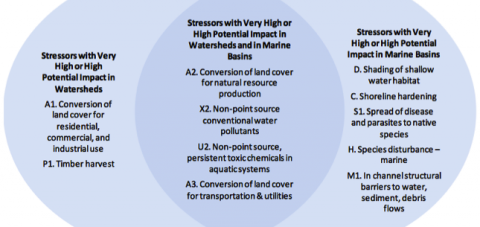Identifying the greatest threats to Puget Sound
In the early days, the polluters were easier to spot. There were the usual suspects—industrial pipes pumped toxic chemicals into the water; dams blocked the way for salmon; natural resources were overharvested. Those problems still persist, but ecosystem management in Puget Sound has become increasingly complicated since the 1970s and 1980s.
In the early days, the polluters were easier to spot. There were the usual suspects—industrial pipes pumped toxic chemicals into the water; dams blocked the way for salmon; natural resources were overharvested. Those problems still persist, but ecosystem management in Puget Sound has become increasingly complicated since the 1970s and 1980s.
Scientists now recognize that what happens on the land is intricately tied to the health of the water. We face climate change and unprecedented population growth, and scientists have identified thousands of different human-caused pressures on the ecosystem. The headlines include new threats like stormwater, emerging contaminants and widespread declines in species and habitats. Given limited resources, how can managers and policymakers make informed decisions about where to focus their recovery efforts?
That was one of the questions behind the 2014 Puget Sound Pressures Assessment. The document, prepared by scientists in cooperation with the Puget Sound Science Panel, identified and ranked some of the greatest threats to the ecosystem. It is expected to provide a blueprint for future recovery efforts, and University of Washington Puget Sound Institute researcher Nick Georgiadis has written a non-technical summary for scientists and policymakers.
The report is now available in the Encyclopedia of Puget Sound.
Recent blog posts
PSI eNews Archives

This Encyclopedia's parent organization, the Puget Sound Institute, also publishes an email newsletter. Visit the PSI blog to subscribe to the PSI eNews or peruse past issues.






